Art/computer work that has interfered with my welding but I never miss an opportunity to collect native plants. I have converted an old kayak rack into a plant drying rack. Stacking up and drying out.
Drying native grasses
Your Custom Text Here
Art/computer work that has interfered with my welding but I never miss an opportunity to collect native plants. I have converted an old kayak rack into a plant drying rack. Stacking up and drying out.
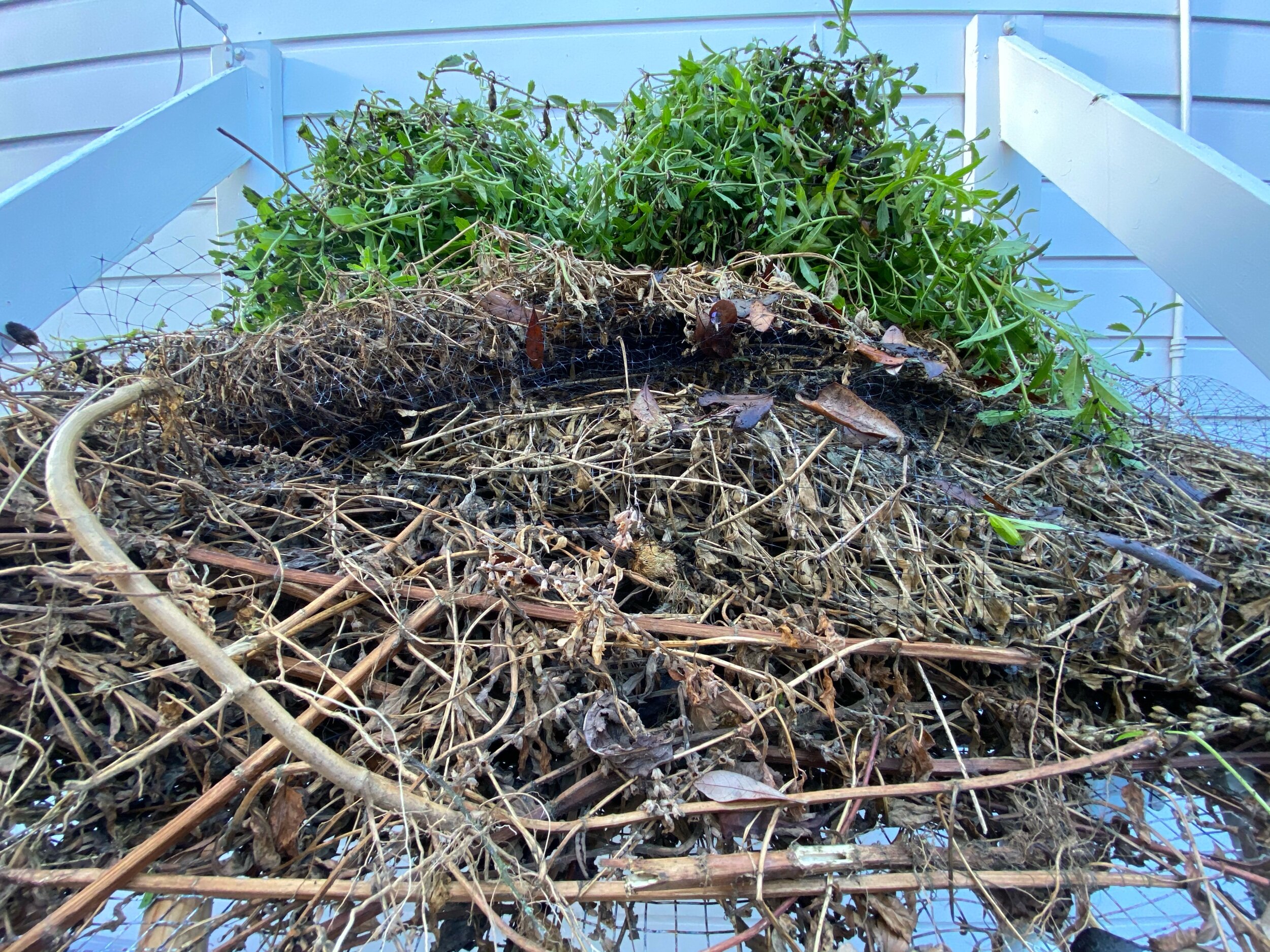
Drying native grasses
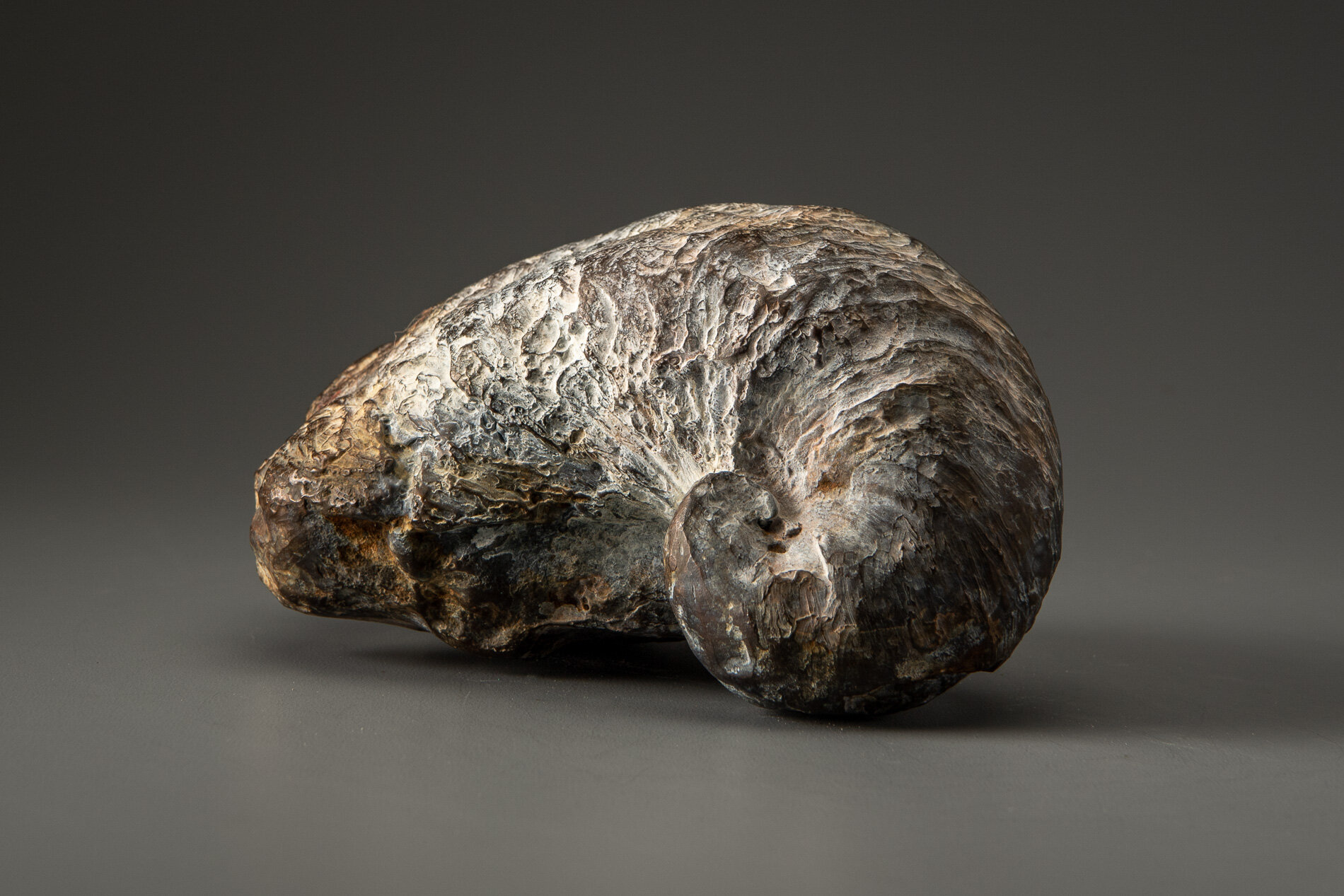
Mute Testimony.
3” X 6” X 4”
bronze
phot by Nash Baker

Stainless Steel finish changes everything 🤔 more to come
My goal for this piece is to embody joy, celebrate life, be complex yet straightforward, and have moments of imperfection.

I will attach to the wax sculpture red wax channels (sprues) and a brown wax cup.
Below the piece is sprued up and ready to dip.
The dipping process builds layer by layer a ceramic shell around the sculpture and sprues. Once the Shell is built I will burnout the wax leaving a hollow cavity to pour the bronze in.


Dip 1 Slurry only





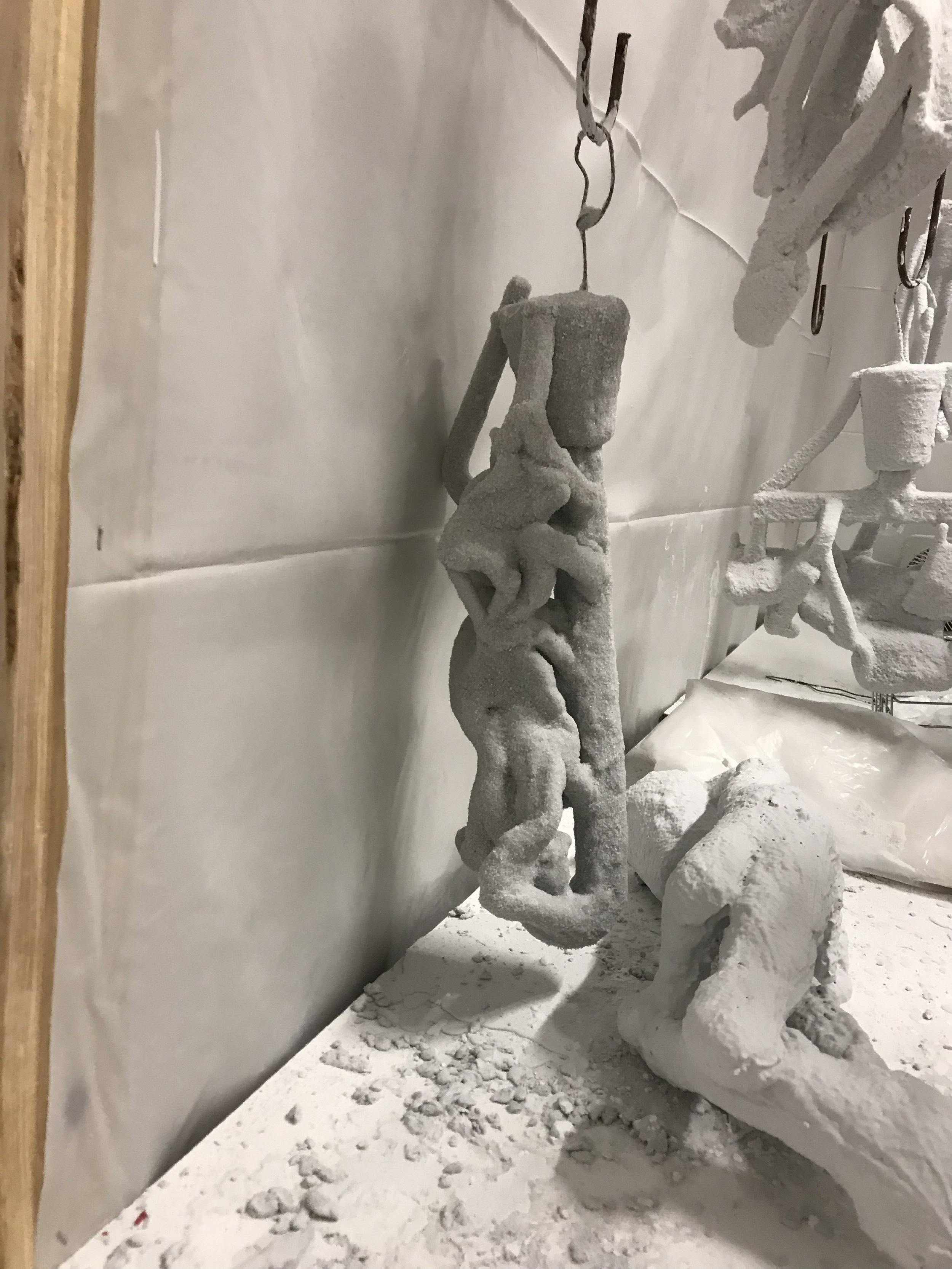



Final coat 24 hours after drying

Cutting the top of the cup and drilling holes to help the expanding gases escape when the wax is burned out.

The piece is now ready to be fired. The firing will harden the shell and melt out the wax sculpture, leaving the cavity for the bronze to be poured into. The wire sticking out will fall out when the wax is burnt out.

We poured the bronze into the shells last night. Now that the shell is cool it is time to break it off and see how it turned out.

the pour-

my shoulder has taken all the pounding it can. I will have to get help to finish breaking off the shell.
In the below images all the metal work is done and the piece is ready to patina.





Adding the white marble patina







As life happens, the lens we see through shifts. The lens I interpret this work through has adapted to current events.
As a result, I am updating my artist statement.
The Shadow of the Texas Rangers - late 1920's, The Texas Rangers in Fabens, Texas (a suburb of El Paso). During prohibition, the Texas Rangers traveled to the Texas/Mexico border, to deter the smuggling of illegally distilled alcohol. While on the border, they boarded in my grandparent's home; they became family friends. My reference photo for these drawings of the Rangers hung in my Grandparent’s home. As a child in the 60’s the photo always intrigued me. I was in awe of the well-heeled, respected law officials confidently posed in front of the rugged mountain and their curiously shaped shadows. I wondered why Granny Gene had a photo of the mythical cowboys and their rifles.
My father did not remember much about the Rangers; ironically, he did remember having a house full of thirsty Texas Rangers and accompanying his father to the edge of the Rio Grande River. His father would leave cash under a rock, the next day a bootlegger from Mexico would wade across the river on a mule, retrieve the compensation and place bottles of booze in the hole under the rock. This is when the term ”mule” surfaced.
The proud history of the Texas Rangers I grew up with has suffered from stories of abuses of power. In the historical photo, the overpowering southwestern sun reveals the dark shadows that tarnish the Rangers’ reputations.
Looking at this image today, through the experiences of 2020, the focus rests heavily on the dark shadows in law enforcement. Unfortunately, the deplorable actions of a few can ruin the reputation of a group. In this drawing, there is a balance of light and dark. It is important to remember history as it was experienced by the people living at the time but it is also important not to turn a blind eye to the dark side of our history. Finding this balance is where we are in 2020. It is time that we hold law enforcement to higher standards and that they find ways to police their own.
There is more good than bad. If you look for it, you will find it. The only reliable way to instill change is to lead by example and to recognize and celebrate those who are doing it right.

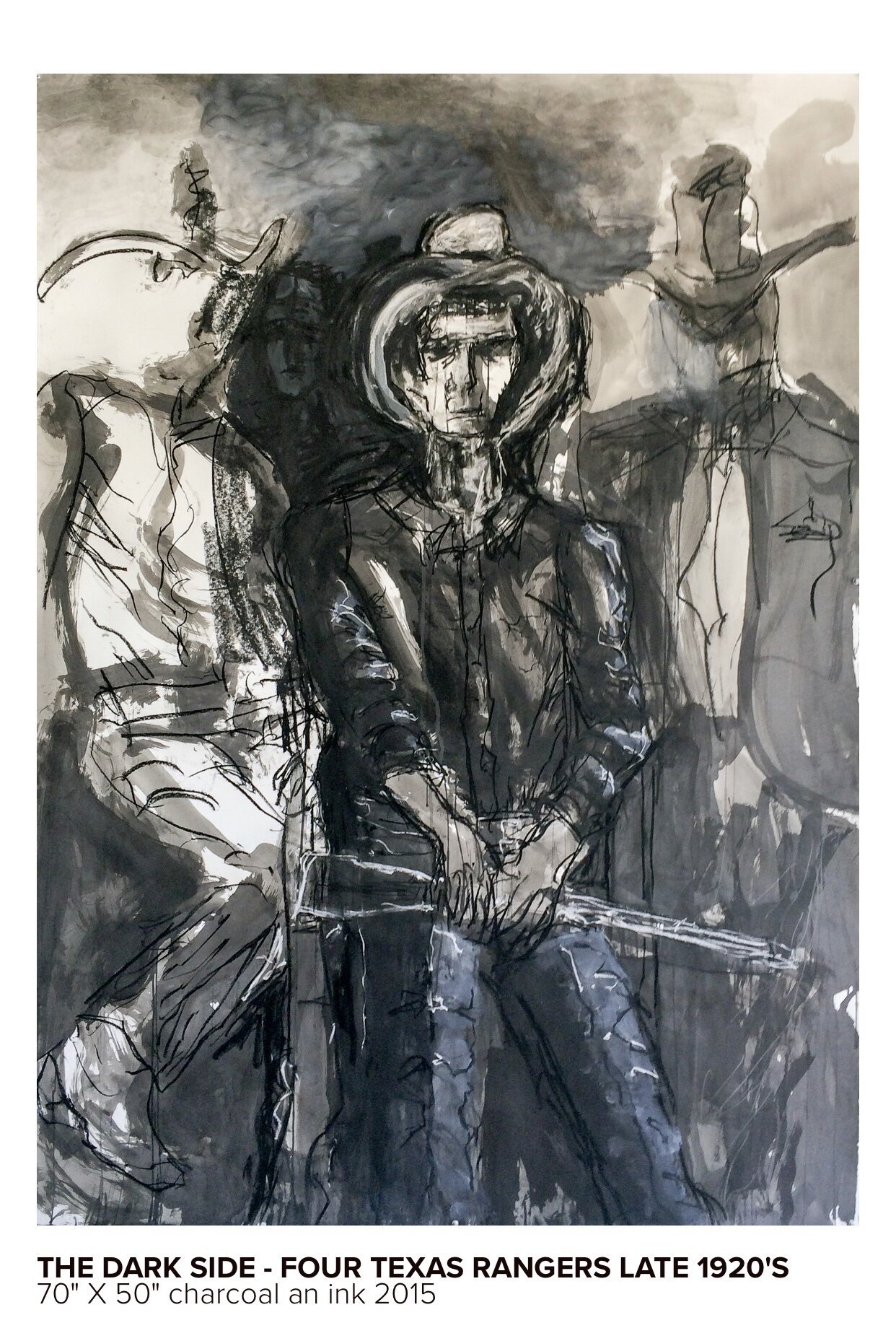
I started this piece 1 1/2 years ago but neglected to have it photographed until this week. Seeing it through the photographer’s eye, it has an additional layer of meaning in 8/2020.
Originally it was a maquette for a memorial piece. We ended up going a different path for the memoriam. Personally I was happy this piece emerged from the event and cast it in bronze. It resonates with me because years ago I became fascinated, completely sucked in by modern neurology. Neurology was my obsession. I read everything a Mom could get her hands on. My favorite was Phantoms in the Brain by V. S. Ramachandran. The brain is amazing and especially since neurologists have learned that it is plastic and is changed with everything you do, everything you tell yourself or others tell you changes your brain. This knowledge is what gives every human a chance for hope. Dreaming is the first step, and self-talk is hugely important. You can control how you see the world, and how you see yourself, “fake it until you make it works“. What you think you will become”.
The additional layer - living through a pandemic is choosing how one reacts to stressful and depressing situations. Humans choose how we react and how we see. “what you think you will become”. The texture of the piece is composed of repetitive arched lines, they are mirrored in the profiles/contours of the work. It is an abstract sculpture but I clearly read “what we think we become”. What we look for we will find, 8/2020 is a good time to control your thoughts and look for the light. If you look for it you will find it.

“what you think you become”
bronze
12” X 4” X 3”

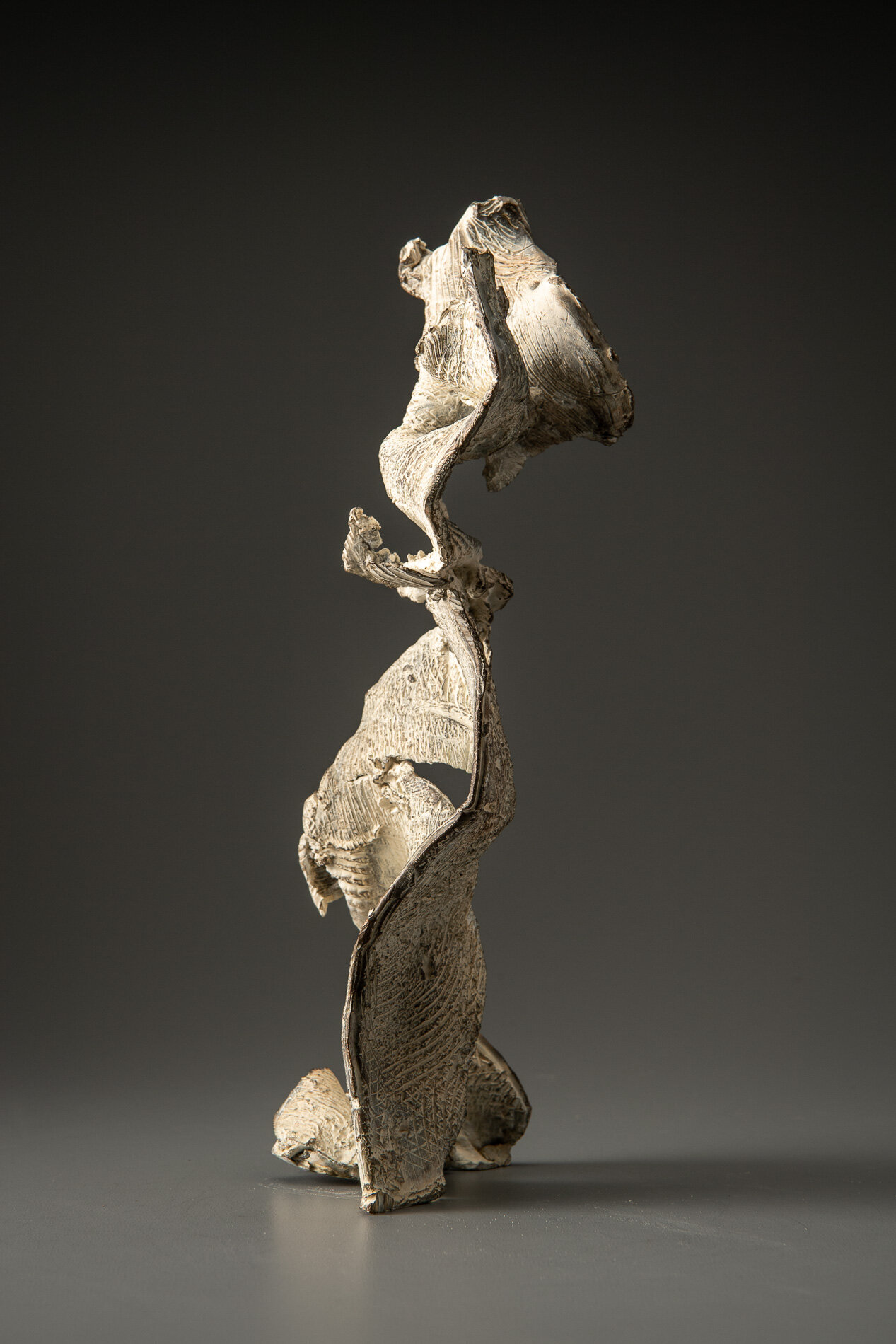
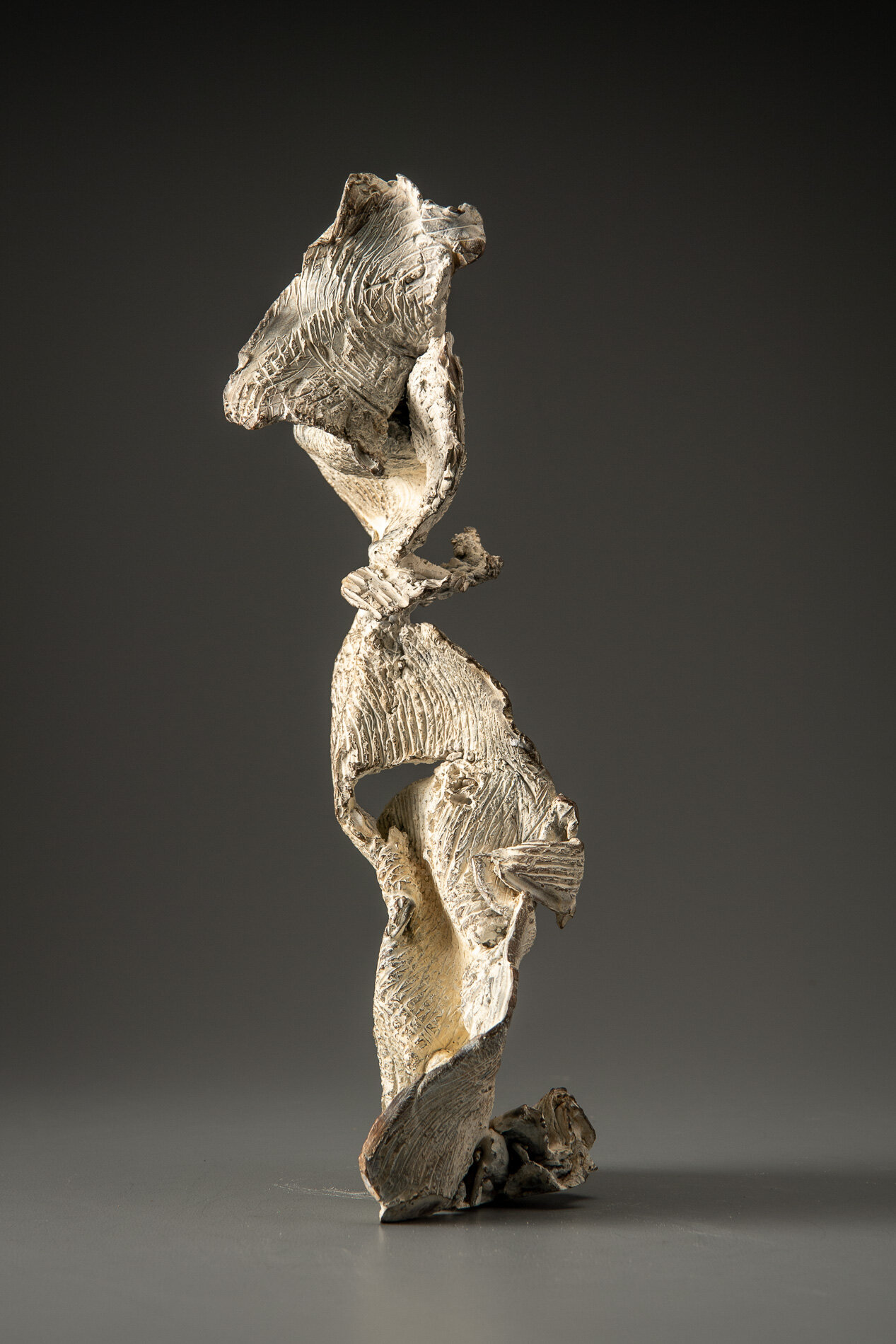
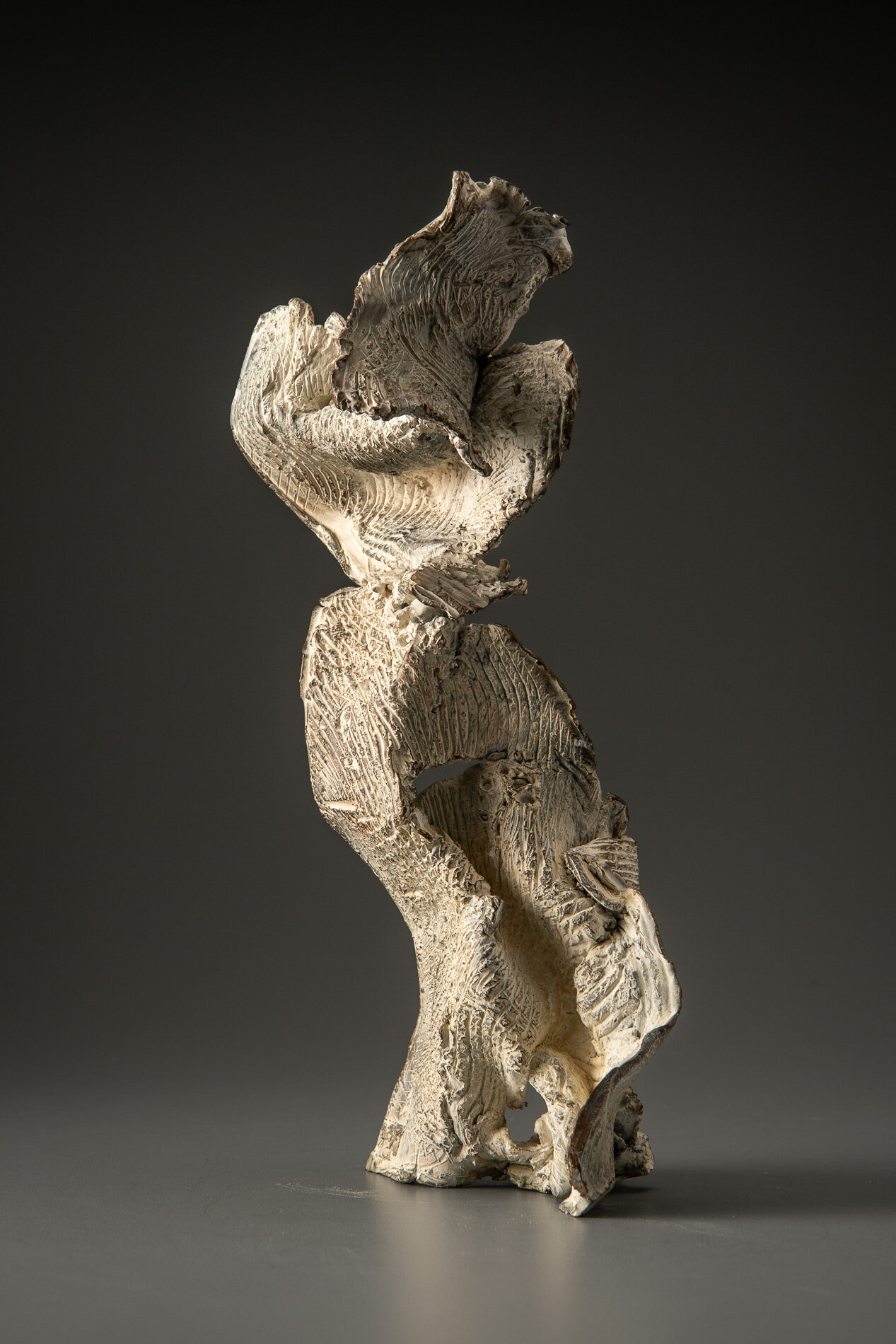


Range by David Epstein - in my mind is a must-read for any artist, creative writer, inventor, scientist moms or anyone who solves problems.
https://pepperdine-graphic.com/book-review-lessons-for-higher-education-in-david-epsteins-range/
”Everyone needs habits of mind that dance across disciplines.”
- D. Epstein

“Habits of mind that dance across disciplines-“ - D. Epstein
I took time this weekend to photograph my studio- just for the memories. I never dreamed I would have an art studio.






One of the ppleasures of having a studio, Is it provides a space to meet with other artists, friends, and art lover acquaintances and get their reactions to my work? Everyone perceives art differently, and it is incredibly beneficial to get feedback from a variety of folks.
Wait! Don’t kill it. Most people I know kill any snakes they find at home. I found this tiny rough earth snake already deceased on my walkway.
They are not venomous and will not hurt you. They actually may help.
He was probably stepped on by my mailperson or dropped by one of the hawks that hangs out in our trees. They are food for the birds we love. When I see creatures that are new to me I always research their role in keeping the natural environment balanced. They normally live underground and probably came out because of our recent rains.
In Houston it is important to note that these creatures live underground creating cavities. When we have rains these cavities become miniature underground reservoirs, holding rain for for drier days.
and we all know that native 🐝 often occupy cavities vacated by other underground dwelling creatures. 🤜🏼🤛🏾 🐍
If you want to make small changes change how you do things if you want to make big changes change how you see.


I see the rough earth snake as a creature I want in my yard.

Osmia Illinoensis
30” X 44” watercolor monotype.


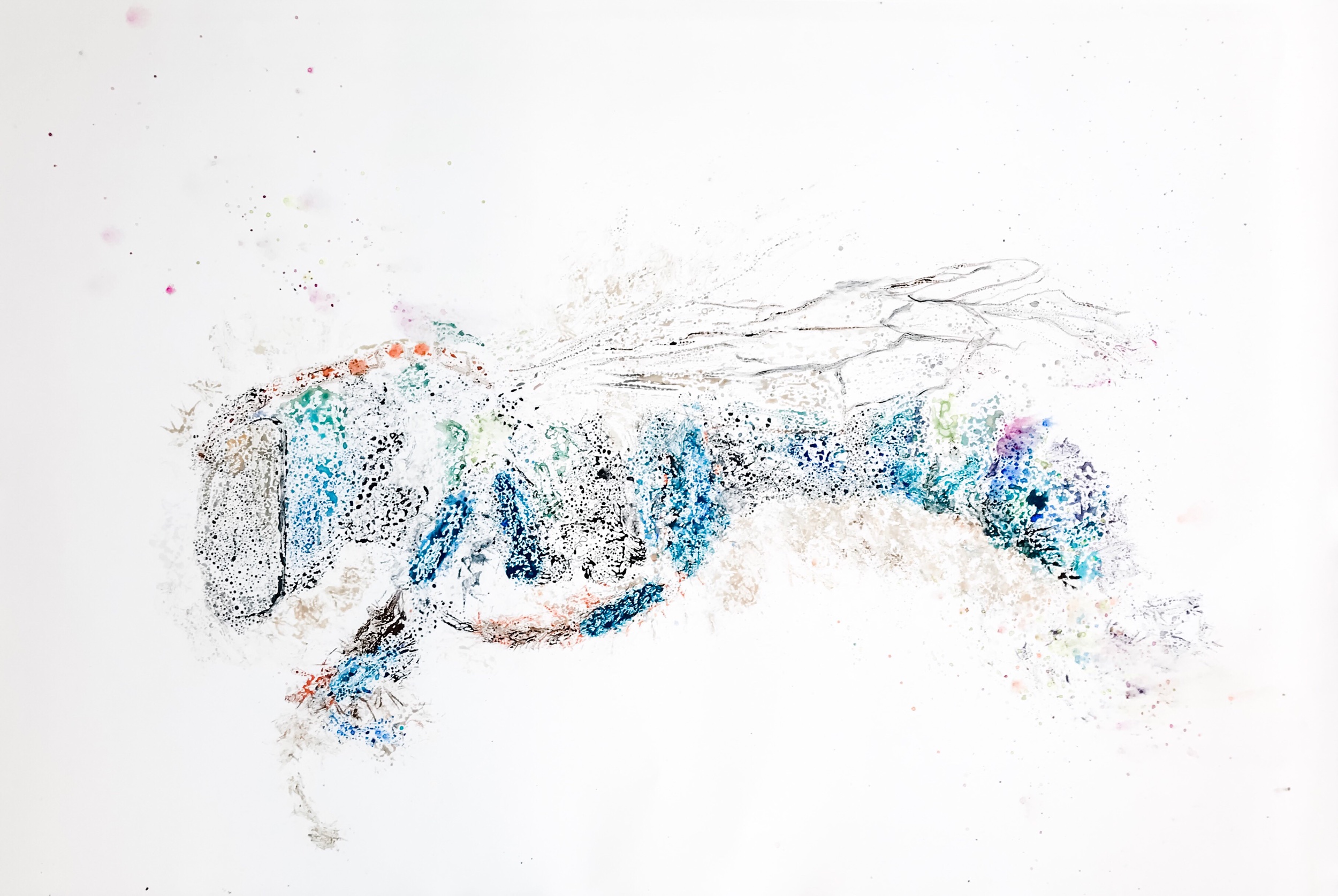

Day two, #2 the ghost





Day 3 caran d’ ache monotype

The ghost

Today I worked on the lower part of it's cheekbones and then I added a rear jawbone.

Looking up the mouth and nose of head minus the lower jaw.

The old guys face left side

Looking through the skull

The right profile.
January 19, 2020


The ranch Anatolian livestock guard dogs greet us at the ranch entrance.

The herd including the cow to be culled having a relaxing morning grazing on Texas prairie grasses. The cow in question will not be separated from the herd, she will not be stressed and will not feel any pain. This is how you humanely harvest an animal. This is not how industrial Agriculture harvests meat.
One wish- if you were selected to make a wish just one and you are the only living creature in the universe that gets this opportunity, what would you wish? I would wish that all humankind would protect and heal our soil.
Can one one wish ripple into social change? Can all of our social unrest and grievances be connected to the health of our soil?
The below tedtalk has me thinking.
https://podcasts.apple.com/us/podcast/ted-talks-daily/id160904630?i=1000405307942
A new Inspiration for work.
”


Here is a collection of my reference material.

Bison grab a tuft of grass with their tongue, then they pinch it off by pressing it between their tongue and their front lower teeth. They do not have top front teeth. They then swallow it whole. That is the beginning of a 24-hour digestive process.

I love this image, I took it last January at Roam Ranch right before the roundup. I think this is the one they call Poppy. Poppy is very curious and friendly. She is checking me out as she catches rain drops on her tongue.

You can see the lower jaw through the upper jaw here. It is slightly off to the right of the bison. I want him chewing away and want to exaggerate the movement. I will probably bend it a little more askew this weekend.

Here the chewing lower jaw is more obvious.


View from the rear or top down.

Friday, I am committing to writing the Lawndale proposal- rewriting and rewriting and rewriting.
I am committed to walking 10,00-15,000 steps every day. During my walks, I listen to audiobooks or podcasts on subjects that interest me. A lot of them have to do with regenerative agriculture, the history of soil, native bees, and various Environmental issues. Often I switch it up and learn about something completely new to me. The information or music I absorb during my walks is a big influence on my work.
Below is a quicky Ted Talk that I was very excited to hear today. It supports my belief that environmental change has got to come from our people in our cities.
https://podcasts.apple.com/us/podcast/ted-talks-daily/id160904630?i=1000485487124
I sent the link to city councilwoman Sally Alcorn and her assistant Hannah. Who knows. Like the piet said- make sure your reach Exceeds your grasp.

I took a screenshot of the description. It feels good to hear other people who believe what I believe.

I needed to make some new concrete sculpting tools. I cut the bristles from a dog brush and glued them to the handle from a sponge 🤞
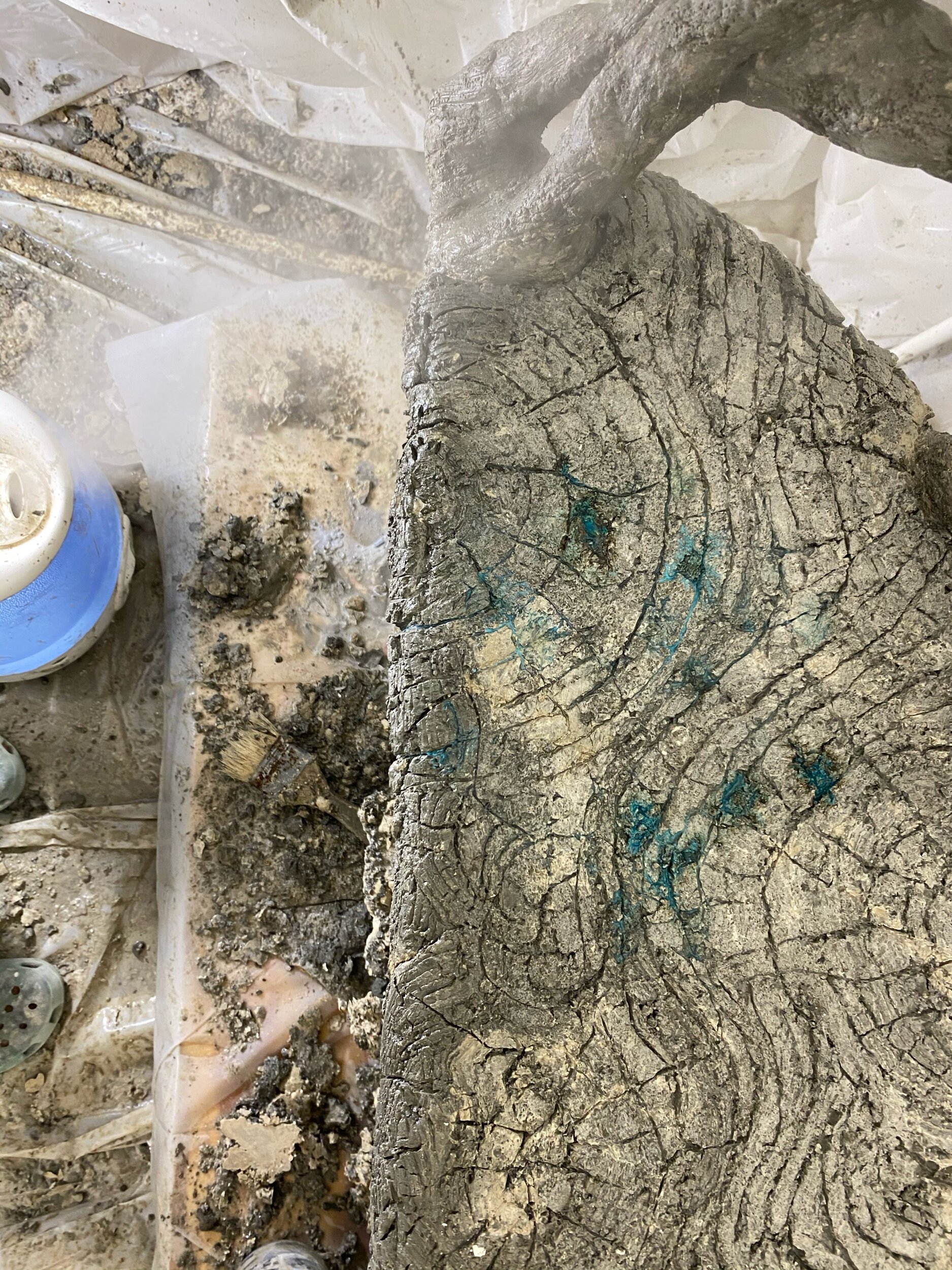
The small bronze root left a stain on the seat. Oops. I expect I can grind it out.

Work work work
If there is an interesting bee it is the orchid bee on many levels. I previously wrote a blog post regarding how orchids trick orchid bees with sex in order to get pollinated. There are endless articles about the interesting habits of orchid bees. They are also one of the most beautiful bees and come in a multitude of gorgeous colors. They are one of the jewels of the bee family.
A fellow Houston artist Jo Ann Fleishhauer recently opened Disquieted Beauty in the Old Jail Art Center this past spring. I was not able to see the exhibit due to Covid. However, the exhibit will open in Houston at Rudolph Blume this fall. In brief the exhibit looks at modes of communication used by the natural world, primarily the orchid bee. The orchid bee uses perfumes from orchids and other living organisms to attract females. Jo Ann’s artistic, complex, layered interpretation of communication is preeminent. You will not want to miss Jo Ann’s Disquieted Beauty when it comes to Houston.
One of the distinguishing characteristic of an orchid bee is their tongue. They have evolved to have a tongue that is twice as long as their body. I stiched a blue and green with beige and brown wings orchid bee in flight with it's tongue physically extended to an abstract orchid.
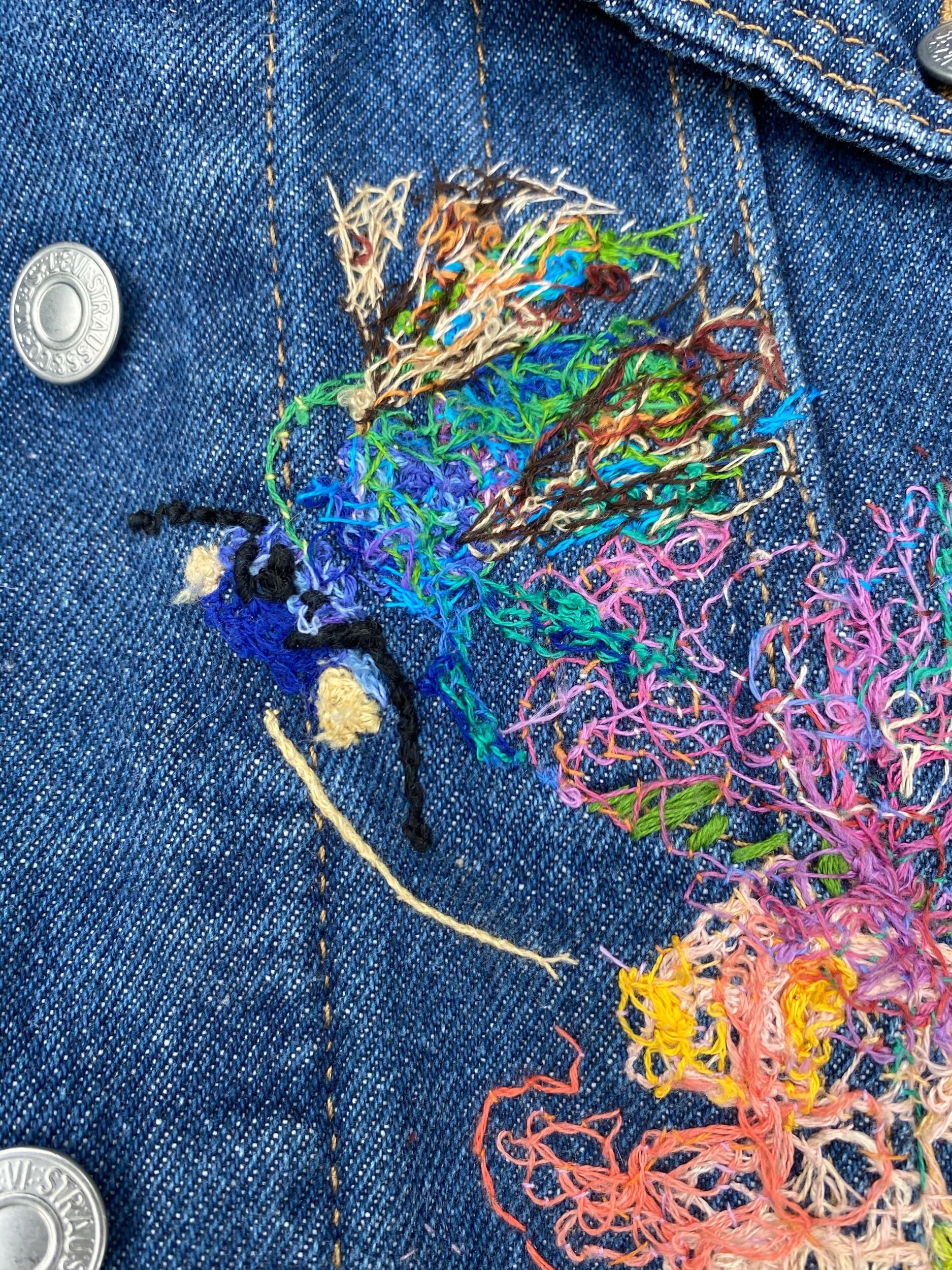
In the natural world, you have to study a habitat to find the minuscule creatures; the same is true with my stitching.

The orchid bee is top left with the super long, whitish tongue.
I was looking forward to making a large watercolor Monoprint of the orchid bee, to add to my Rumblings body of work. Unfortunately, due to COVID 19 I no longer have access to a press. For now Rumbling monoprints are temporarily on hold but I can still stitch as many bees as I like. I am working on some other pieces that are very important to me and I love getting in my pond and photographing its life.
I am getting close to finishing the head and upper jaw. The next step will be to create the lower jaw, then I will put the head aside and start building up the piece from the hooves.

More work on the cheekbones and connecting the horns to the eyes.

Side view of armature

Bottom side view

Bison's left side view

Back of head looking down
For the full story see Endangered Knowledge: The Soul of Humus #1a
for the full story see Endangered Knowledge: The Soul of Humus





for the full story see Endangered Knowledge: The Soul of Humus

View l from the mouth

The cheekbones are added.
For the full story see Endangered Knowledge: The Soul of Humus